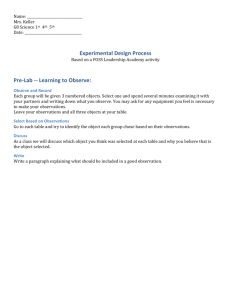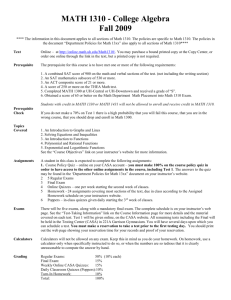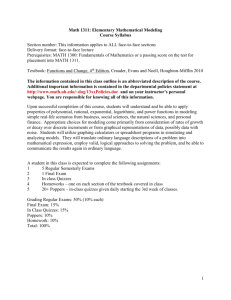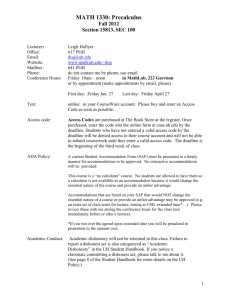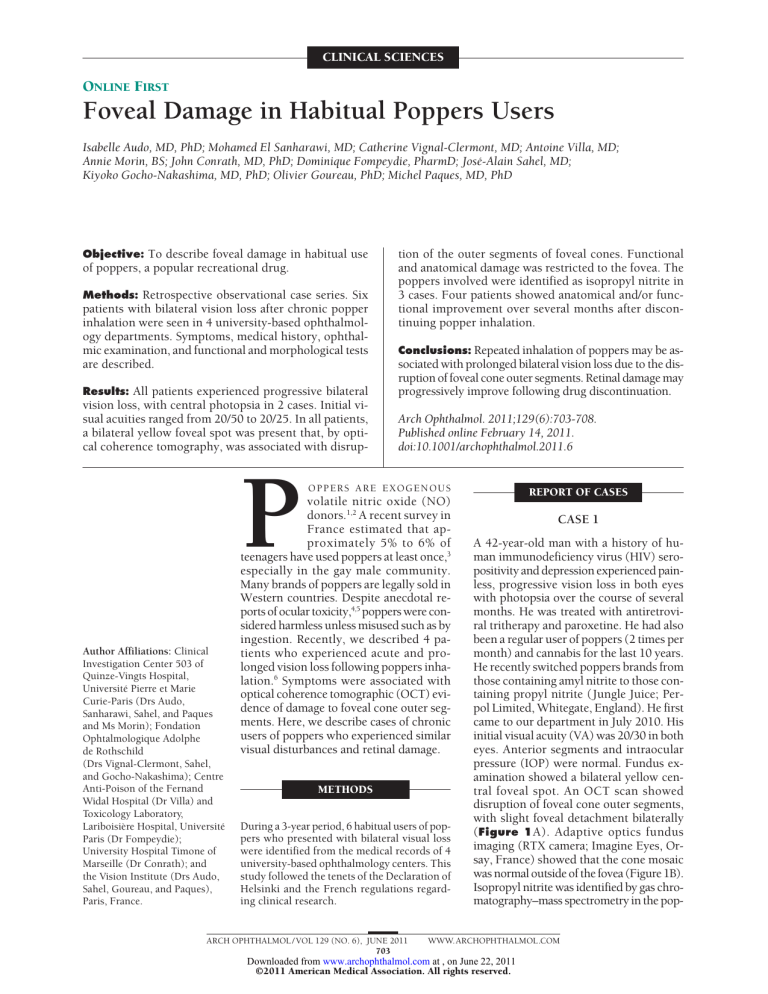
CLINICAL SCIENCES
ONLINE FIRST
Foveal Damage in Habitual Poppers Users
Isabelle Audo, MD, PhD; Mohamed El Sanharawi, MD; Catherine Vignal-Clermont, MD; Antoine Villa, MD;
Annie Morin, BS; John Conrath, MD, PhD; Dominique Fompeydie, PharmD; José-Alain Sahel, MD;
Kiyoko Gocho-Nakashima, MD, PhD; Olivier Goureau, PhD; Michel Paques, MD, PhD
Objective: To describe foveal damage in habitual use
of poppers, a popular recreational drug.
Methods: Retrospective observational case series. Six
patients with bilateral vision loss after chronic popper
inhalation were seen in 4 university-based ophthalmology departments. Symptoms, medical history, ophthalmic examination, and functional and morphological tests
are described.
Results: All patients experienced progressive bilateral
vision loss, with central photopsia in 2 cases. Initial visual acuities ranged from 20/50 to 20/25. In all patients,
a bilateral yellow foveal spot was present that, by optical coherence tomography, was associated with disrup-
P
Author Affiliations: Clinical
Investigation Center 503 of
Quinze-Vingts Hospital,
Université Pierre et Marie
Curie-Paris (Drs Audo,
Sanharawi, Sahel, and Paques
and Ms Morin); Fondation
Ophtalmologique Adolphe
de Rothschild
(Drs Vignal-Clermont, Sahel,
and Gocho-Nakashima); Centre
Anti-Poison of the Fernand
Widal Hospital (Dr Villa) and
Toxicology Laboratory,
Lariboisière Hospital, Université
Paris (Dr Fompeydie);
University Hospital Timone of
Marseille (Dr Conrath); and
the Vision Institute (Drs Audo,
Sahel, Goureau, and Paques),
Paris, France.
tion of the outer segments of foveal cones. Functional
and anatomical damage was restricted to the fovea. The
poppers involved were identified as isopropyl nitrite in
3 cases. Four patients showed anatomical and/or functional improvement over several months after discontinuing popper inhalation.
Conclusions: Repeated inhalation of poppers may be associated with prolonged bilateral vision loss due to the disruption of foveal cone outer segments. Retinal damage may
progressively improve following drug discontinuation.
Arch Ophthalmol. 2011;129(6):703-708.
Published online February 14, 2011.
doi:10.1001/archophthalmol.2011.6
OPPERS ARE EXOGENOUS
volatile nitric oxide (NO)
donors.1,2 A recent survey in
France estimated that approximately 5% to 6% of
teenagers have used poppers at least once,3
especially in the gay male community.
Many brands of poppers are legally sold in
Western countries. Despite anecdotal reports of ocular toxicity,4,5 poppers were considered harmless unless misused such as by
ingestion. Recently, we described 4 patients who experienced acute and prolonged vision loss following poppers inhalation.6 Symptoms were associated with
optical coherence tomographic (OCT) evidence of damage to foveal cone outer segments. Here, we describe cases of chronic
users of poppers who experienced similar
visual disturbances and retinal damage.
METHODS
During a 3-year period, 6 habitual users of poppers who presented with bilateral visual loss
were identified from the medical records of 4
university-based ophthalmology centers. This
study followed the tenets of the Declaration of
Helsinki and the French regulations regarding clinical research.
ARCH OPHTHALMOL / VOL 129 (NO. 6), JUNE 2011
703
REPORT OF CASES
CASE 1
A 42-year-old man with a history of human immunodeficiency virus (HIV) seropositivity and depression experienced painless, progressive vision loss in both eyes
with photopsia over the course of several
months. He was treated with antiretroviral tritherapy and paroxetine. He had also
been a regular user of poppers (2 times per
month) and cannabis for the last 10 years.
He recently switched poppers brands from
those containing amyl nitrite to those containing propyl nitrite (Jungle Juice; Perpol Limited, Whitegate, England). He first
came to our department in July 2010. His
initial visual acuity (VA) was 20/30 in both
eyes. Anterior segments and intraocular
pressure (IOP) were normal. Fundus examination showed a bilateral yellow central foveal spot. An OCT scan showed
disruption of foveal cone outer segments,
with slight foveal detachment bilaterally
(Figure 1A). Adaptive optics fundus
imaging (RTX camera; Imagine Eyes, Orsay, France) showed that the cone mosaic
was normal outside of the fovea (Figure 1B).
Isopropyl nitrite was identified by gas chromatography–mass spectrometry in the pop-
WWW.ARCHOPHTHALMOL.COM
Downloaded from www.archophthalmol.com at , on June 22, 2011
©2011 American Medical Association. All rights reserved.
A
B
Figure 1. Case 1 at presentation (visual acuity, 20/30 OU). Optical coherence tomography (A) and adaptive optics fundus images (B) of both eyes show damage to
the foveal cone outer segment bilaterally (arrows). The cone mosaic appears normal outside of the fovea.
pers vial. Interruption of poppers was recommended but
the patient was unwilling to comply. Three months later,
results of ophthalmological examination were unchanged.
CASE 2
A 56-year-old man with a history of HIV seropositivity and
depression experienced painless, progressive vision loss
in both eyes over the course of several months. He was
treated with antiretroviral tritherapy. He had also been a
regular user of various brands of poppers (at least once
per week) for more than 20 years and was a cocaine and
chloral hydrate user. He recently switched poppers brands
from those containing amyl nitrite to those containing propyl nitrite. He first came to our department in October 2008.
He spontaneously attributed his loss of vision to poppers
on chronological arguments. At that time, his VA was 20/40
OD, 20/50 OS. Anterior segments and IOP were normal.
Fundus examination showed bilateral foveal yellow spots
(Figure 2A). Autofluorescence fundus images revealed
a perifoveal decrease in lutheal pigment absorption of the
laser with pseudohyperautofluorescence (Figure 2B). Fluorescein angiography showed a bilateral window defect of
the central fovea (Figure 2C). An OCT scan showed disruption of foveal cone outer segments, with a slight foveal detachment bilaterally (Figure 2D). Color vision, visual fields, and findings of full-field electroretinography
(ERG) were normal. Multifocal ERG showed bilateral attenuation of central responses. Toxicological analysis of
a vial of the brand most often taken by the patient revealed the presence of isopropyl nitrite, with no other detectable compound. The patient agreed to stop taking poppers. Subsequently, a progressive improvement in VA to
20/32 OD and 20/40 OS was observed during follow-up
examinations over several months, as well as a partial regression of OCT changes.
CASE 3
A 39-year-old man with seropositive results of testing for
HIV who was treated with antiprotease (tenofovir) expe-
rienced painless, progressive visual loss in both eyes. He
was a regular weekly popper user, with increasing doses
over the last 3 to 4 months. The patient spontaneously attributed vision loss to consumption of poppers. He was
first seen in our department in December 2007. At that
time, his VA was 20/25 OD and 20/40 OS. Anterior segments and IOP were normal. Fundus examination revealed a bilateral foveal yellow spot. Fluorescein angiography showed bilateral window defect in the central fovea.
An OCT scan showed bilateral disruption of foveal cone
outer segments. Color vision, visual fields, and findings
of full-field ERG were normal. A follow-up examination
performed 1 month later showed an improvement in VA
to 20/20 in both eyes but his OCT images were unchanged. The patient was then lost to follow-up.
CASE 4
A 53-year-old man with a history of HIV seropositivity
and syphilis experienced painless, progressive vision loss
in both eyes over several months. He was treated with
antiretroviral tritherapy. He had also been a regular user
of poppers (at least once per week) for 3 to 4 years but
denied using any other drugs. He first came to our department in December 2009. His VA was 20/32 OD, 20/50
OS. Anterior segments and IOP were normal. Fundus
examination showed bilateral foveal yellow spots. Spectraldomain OCT showed disruption of foveal cone outer segments. Color vision, visual fields, and findings of fullfield ERGs were normal. Multifocal ERG showed slight
bilateral attenuation of central responses. Interruption
of poppers was recommended. A follow-up examination performed 3 months later showed an improvement
in VA to 20/32 in both eyes, with a slight improvement
of OCT features.
CASE 5
A 35-year-old man with a history of HIV seropositivity
and syphilis experienced painless, progressive vision loss
with photopsia in both eyes over several months. He was
treated with antiretroviral tritherapy. He had also been
ARCH OPHTHALMOL / VOL 129 (NO. 6), JUNE 2011
704
WWW.ARCHOPHTHALMOL.COM
Downloaded from www.archophthalmol.com at , on June 22, 2011
©2011 American Medical Association. All rights reserved.
A
B
C
D
ONL
ONL/IS
IS/OS
200 µm
RPE
Figure 2. Case 2. Color photographs (A), 488-nm autofluorescence (B), fluorescein angiography (C), and optical coherence tomographic images (D) at
presentation (visual acuity, 20/40 OD, 20/50 OS). Note the bilateral yellow spot (arrowheads), the central window defect on the fluorescein angiogram, and the
disorganization of foveal cone outer segments with subretinal fluid. ONL indicates outer nuclear layer; IS, inner segment; OS, outer segment; RPE, retinal pigment
epithelium.
a regular user of poppers (3 to 4 times per week, most
frequently the brand name Jungle Juice Platinum) and
of cannabis for the last 3 years. He first came to our department in December 2009. His VA was 20/50 OD, 20/40
OS. Anterior segments and IOP were normal. Fundus examination showed bilateral foveal yellow spots. Spectraldomain OCT showed a slight foveal detachment bilaterally. Visual fields and findings of full-field ERG were
normal. Multifocal ERG showed slightly attenuated central responses. Isopropyl nitrite was identified by gas in
the poppers vial. Interruption of poppers was recom-
mended. A follow-up examination performed 2 months
later showed an improvement in VA to 20/25 OD, and
20/32 OS.
CASE 6
A 45-year-old man came to our unit in December 2008.
He had been experiencing painless, rapidly progressive
vision loss in both eyes for 1 month. He had a history of
depression and was treated with fluoxetine, chlordiazepoxide, sibutramine, and spironolactone. He had been
ARCH OPHTHALMOL / VOL 129 (NO. 6), JUNE 2011
705
WWW.ARCHOPHTHALMOL.COM
Downloaded from www.archophthalmol.com at , on June 22, 2011
©2011 American Medical Association. All rights reserved.
A
Right eye
Left eye
December 2008
B
January 2009
C
200 µm
April 2009
Figure 3. Case 6. A, Optical coherence tomographic scans at presentation are shown (visual acuity, 20/30 OU). Note the bilateral disruption of the optical
reflectance of outer segments of central cones (arrows). During follow-up (B and C), there was progressive normalization in the images; the final visual acuity was
20/20 OU.
taking poppers on a weekly basis (brand name, Jungle
Juice) over several months. His initial VA was 20/30 in
both eyes. Anterior segments and IOP were normal.
Fundus examination showed slight yellow central foveal spots. A presumptive diagnosis of optic neuritis led
to prednisolone bolus therapy (1 mg/kg). Subsequently,
visual evoked potentials were found to be normal,
which led to prednisolone discontinuation. High-resolution OCT then revealed bilateral disruption of foveal
cone outer segments (Figure 3A). Color vision, visual
fields, and findings of full-field ERG were normal.
Medical evaluation also revealed HIV seropositivity and
tertiary syphilis, and the patient was subsequently appropriately treated. The patient agreed to stop taking
poppers. Follow-up examinations showed progressive
normalization of functional and morphological abnormalities (Figure 3, B and C).
SUMMARY OF CASE REPORTS
We observed 6 cases of bilateral vision loss after chronic
popper intake between December 2007 and July 2010.
All patients were HIV-positive men. All were regular
popper users and reported a reduction in vision during
several weeks to months before seeking medical advice.
Three patients took other psychoactive substances,
such as cannabis and cocaine, simultaneously with poppers. Two patients described central photopsia in both
eyes. On initial examination, VA ranged from 20/50 to
20/25. Fundus examinations revealed a yellow foveal
spot in all cases. An OCT scan showed disruption in the
reflectivity of the central photoreceptor outer segments
in all cases, with a slight foveal detachment in 3 pa-
tients. In patients who underwent fluorescein angiography, a centrofoveal window defect was found but no
evidence of fluid leakage. Color vision, visual fields including microperimetry, and findings of full-field ERG
were normal or showed minimal abnormalities. Multifocal ERG showed reduced amplitudes for central responses in 3 patients. A complete or a partial regression
of symptoms and fundus abnormalities was noted in the
4 patients who claimed to have discontinued popper intake. There were no pigmentary changes at any time.
Isopropyl nitrite has been identified in the vials taken
by 3 of them.
COMMENT
Popper-related damage to foveal cone outer segments is
a recently recognized entity.6 We previously described
4 cases of acute toxicity in which vision loss occurred
after a single exposure to poppers and persisted for several weeks. Other causes of yellow foveal spots were ruled
out by context and OCT findings such as stage 1 macular hole, niacin maculopathy, or best-like dystrophy. All
patients described here were HIV positive; however, this
is probably coincidental because poppers are popular
among the gay community and the cases described by
us6 were in HIV-negative subjects.
To our knowledge, during the past 10 years there
have been only 2 case reports of vision loss following
inhalation of poppers.4,5 A similar case of vision loss has
been reported by Pece et al,4 in which a patient experienced acute, bilateral vision loss hours after inhaling
isobutyl nitrite. Their patient had bilateral foveal spots
ARCH OPHTHALMOL / VOL 129 (NO. 6), JUNE 2011
706
WWW.ARCHOPHTHALMOL.COM
Downloaded from www.archophthalmol.com at , on June 22, 2011
©2011 American Medical Association. All rights reserved.
but normal findings on time-domain OCTs and experienced a spontaneously favorable clinical course over
several weeks. Normal findings on time-domain OCT
scan does not, however, rule out the presence of minute
foveal damage. Indeed, in our cases, careful, iterative
scanning of the fovea by OCT was often necessary to
highlight disruption of central outer segments, a procedure that is easier to perform with current high-speed,
high-resolution spectral-domain OCTs. The finding of
minute foveal damage may also be complicated by the
fact that patients will tend to avoid fixation into this
area. The case described by Fledelius5 was of acute and
severe bilateral optic neuropathy, but the relationship
with poppers was disputable; viral optic neuritis was a
more likely diagnosis.
These findings raised the question of the effect of repeated poppers intake. We report here that there is no
evidence of extrafoveal extension of the lesions or of aggravation of visual loss, even after several years of poppers intake. Hence, poppers-related foveal toxicity is not
cumulative, is restricted to the fovea even after prolonged exposure, and causes overall limited visual impairment in the long term. Improvement after interruption appears to be the rule, although our data are still
incomplete regarding this point.
Given the absence of a detectable contaminant in the
poppers vials examined to date, it is likely that visual
symptoms were directly linked to NO intake. However,
the putative mechanisms linking poppers to retinal toxicity remain elusive. There is little knowledge regarding
the pharmacological effects of inhaled alkyl nitrites on
neural tissues.7,8 At physiological doses, NO modulates
photoreceptor metabolism and function,9,10 in particular through activation of guanylate cyclase, a key enzyme of phototransduction.11 The presence of photopsias in many patients suggests permanent activation of
central cones rather than their inhibition, which would
be expected if only guanylate cyclase activation was involved. Accordingly, an increased ERG after NO administration was described in rats,12 and another study suggested that NO potentiates the light response of cones,
while it decreases that of rods.13 At higher doses, it has
been shown that photoreceptors are among the most sensitive retinal neurons to the toxic effects of NO, both in
vitro and in vivo.14,15 Nitric oxide is also known to decrease the threshold of light toxicity.16,17 Yet, these studies were performed in retinas that do not have a fovea;
thus, their relevance to the clinical toxicity described here
is questionable. Accordingly, the elective targeting of the
fovea in our patients suggests light-induced damage, although patients denied having stared at bright lights.
Moreover, in addition to their effect on neuronal metabolism, it has been reported that NO interacts with the
macular pigment zeaxanthin,18 which protects the fovea
against light damage. In our patients, the presence of a
central increase in autofluorescence and a central window defect and the absence of pigmentary changes even
after months of exposure suggest a defect of macular pigment that may potentiate light toxicity. Measuring the
concentration of macular pigment in these patients may
thus be of interest to understand the physiopathology of
the affection.
Vision loss following poppers intake could be considered to be a rare event, although in Web forums discussing poppers effects, photopsia is reported as a common adverse effect. Therefore, the reason for the apparent
outbreak of popper toxicity that we describe remains to
be determined. It may be due to the conjunction of an
increased use of popper in the population as reported in
France in recent surveys (http://www.ofdt.fr/BDD
/publications/docs/eisxacp6.pdf), the availability of more
powerful popper brands, and/or to improvements in retinal imaging technologies. Indeed, the results of an ophthalmological examination may be considered normal if
the careful search for a yellow foveal spot and damage
to foveal cone outer segments has not been carefully done.
In this regard, the recent availability of spectral-domain
OCT technology considerably facilitated such diagnosis
because of the higher speed of acquisition and of the higher
resolution. Also, many popper users with transient visual symptoms may not request medical advice or may
not report popper consumption.
Several recommendations may be drawn from these
findings. Consumers and ophthalmologists should be
aware of the possible long-term retinal toxicity of isopropyl nitrite, and possibly of all brands of poppers. In
cases of unexplained bilateral vision loss with central scotoma, especially in presence of photopsia and/or yellow
foveal spots, toxicity related to poppers should be considered as a possible diagnosis. Specific questioning and
a careful search for foveal damage by high-resolution OCT
should be conducted to ascertain the diagnosis. There may
be an improvement in symptoms following drug discontinuation. Finally, the determination of the molecular basis of the toxic effects of poppers may be of interest to
further document the role of NO in retinal function and
diseases and to identify protective mechanisms against
such toxicity.
Submitted for Publication: September 24, 2010; final revision received November 11, 2010; accepted November 24, 2010.
Published Online: February 14, 2011. doi:10.1001
/archophthalmol.2011.6
Correspondence: Michel Paques, MD, PhD, Centre Hospitalier National des Quinze-Vingts, 28 rue de Charenton, 75012 Paris, France (mp@cicoph.org).
Financial Disclosure: None reported.
Funding/Support: This study was supported by the Institut National de la Recherche Médicale, the Direction
de l’Hospitalisation et des Soins, the French National Research Agency (ANR-09-TECS-009 iPhot), and the Foundation Fighting Blindness (grants CD-CL-0808-0466CHNO and C-CMM-0907-0428-INSERM04; Dr Audo).
REFERENCES
1. Romanelli F, Smith KM, Thornton AC, Pomeroy C. Poppers: epidemiology and
clinical management of inhaled nitrite abuse. Pharmacotherapy. 2004;24(1):
69-78.
2. Bogart L, Bonsignore J, Carvalho A. Massive hemolysis following inhalation of
volatile nitrites. Am J Hematol. 1986;22(3):327-329.
3. Legleye S, Le Nezet O, Spilka S, Beck F. Drug use among adolescents and young
adults between 2000 and 2005, France. Bull Epidemiol Hebdo. 2008;13:8996.
ARCH OPHTHALMOL / VOL 129 (NO. 6), JUNE 2011
707
WWW.ARCHOPHTHALMOL.COM
Downloaded from www.archophthalmol.com at , on June 22, 2011
©2011 American Medical Association. All rights reserved.
4. Pece A, Patelli F, Milani P, Pierro L. Transient visual loss after amyl Isobutyl nitrite abuse. Semin Ophthalmol. 2004;19(3-4):105-106.
5. Fledelius HC. Irreversible blindness after amyl nitrite inhalation. Acta Ophthalmol Scand. 1999;77(6):719-721.
6. Vignal-Clermont C, Audo I, Sahel JA, Paques M. Poppers-associated retinal toxicity.
N Engl J Med. 2010;363(16):1583-1585.
7. Balster RL. Neural basis of inhalant abuse. Drug Alcohol Depend. 1998;51(1-2):
207-214.
8. Thatcher GR, Nicolescu AC, Bennett BM, Toader V. Nitrates and NO release: contemporary aspects in biological and medicinal chemistry. Free Radic Biol Med.
2004;37(8):1122-1143.
9. Goldstein IM, Ostwald P, Roth S. Nitric oxide: a review of its role in retinal function and disease. Vision Res. 1996;36(18):2979-2994.
10. Kourennyi DE, Liu XD, Hart J, Mahmud F, Baldridge WH, Barnes S. Reciprocal
modulation of calcium dynamics at rod and cone photoreceptor synapses by nitric oxide. J Neurophysiol. 2004;92(1):477-483.
11. Koch KW, Lambrecht HG, Haberecht M, Redburn D, Schmidt HH. Functional coupling of a Ca2⫹/calmodulin-dependent nitric oxide synthase and a soluble guanylyl cyclase in vertebrate photoreceptor cells. EMBO J. 1994;13(14):33123320.
12. Vielma A, Delgado L, Elgueta C, Osorio R, Palacios AG, Schmachtenberg O.
Nitric oxide amplifies the rat electroretinogram. Exp Eye Res. 2010;91(5):700709.
13. Sato M, Ohtsuka T. Opposite effects of nitric oxide on rod and cone photoreceptors of rat retina in situ. Neurosci Lett. 2010;473(1):62-66.
14. Fawcett RJ, Osborne NN. Flupirtine attenuates sodium nitroprusside-induced
damage to retinal photoreceptors, in situ. Brain Res Bull. 2007;73(4-6):278288.
15. Komeima K, Usui S, Shen J, Rogers BS, Campochiaro PA. Blockade of neuronal
nitric oxide synthase reduces cone cell death in a model of retinitis pigmentosa.
Free Radic Biol Med. 2008;45(6):905-912.
16. Donovan M, Carmody RJ, Cotter TG. Light-induced photoreceptor apoptosis in
vivo requires neuronal nitric-oxide synthase and guanylate cyclase activity and
is caspase-3-independent. J Biol Chem. 2001;276(25):23000-23008.
17. Goureau O, Jeanny JC, Becquet F, Hartmann MP, Courtois Y. Protection against
light-induced retinal degeneration by an inhibitor of NO synthase. Neuroreport.
1993;5(3):233-236.
18. Scheidegger R, Pande AK, Bounds PL, Koppenol WH. The reaction of peroxynitrite with zeaxanthin. Nitric Oxide. 1998;2(1):8-16.
One cannot gain skill and experience in cataract operations without doing less than the
best. I will illustrate this by a case from my
own experience. It occurred while I was undergoing my apprenticeship to Major Smith
at Jullunder. It happened, at the time, that I
was under the influence of quinine, and to
add to my troubles I had as spectator a distinguished stranger.
When the lens was nearly three quarters
delivered and I was on the point of hooking
it out a bead of vitreous appeared beside it
and threatened to burst. Instead of doing what
I should have done, what I should do now,
and perhaps what I would have done then
had my nerves been steadier and my judgment unperturbed, instead of doing the right
thing I did the wrong. I suddenly lifted mu
[sic] hook to relieve all pressure from the eye,
with the result that the lens, which was more
than half delivered, dropped back into the eye
with sufficient impetus to become buried in
the vitreous.
Source: McKechnie WE. Cataract operations and
the preparation of the surgeon. Arch Ophthalmol.
1911;40:27.
ARCH OPHTHALMOL / VOL 129 (NO. 6), JUNE 2011
708
WWW.ARCHOPHTHALMOL.COM
Downloaded from www.archophthalmol.com at , on June 22, 2011
©2011 American Medical Association. All rights reserved.



